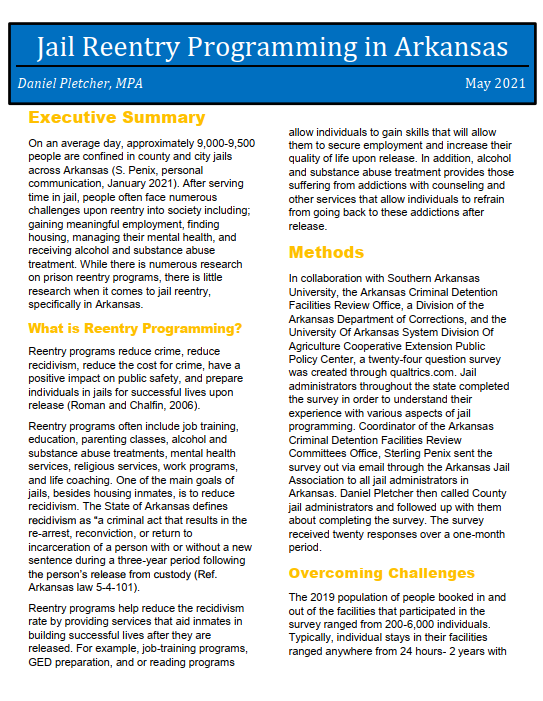Rural Criminal Justice
Every year, 11 million people cycle through county and city jails in the United States while a half-million more people are released from state or federal prisons. In Arkansas, incarceration and pre-trial detention have grown since the 1970s. County governments spend more than one-third of their annual budgets on public safety.
In addition to the direct expense to communities, a person’s arrest record, criminal charge, or a conviction are barriers to many activities we take for granted. This includes finding housing, earning money, obtaining transportation and other resources needed to live safe and healthy lives.
The Public Policy Center at the University of Arkansas System Division of Agriculture offers resources to raise awareness about criminal justice issues in our rural state.

Arkansas Re-Entry Simulation
The Arkansas Re-Entry Simulation uses four 15-minute weeks to model one month in the life of an adult who recently left prison.
Participants assume the identity of a former prisoner and must complete a series of tasks each week to succeed and avoid going back to jail. The simulation involves 14 stations where volunteers and participants explore and discuss the re-entry process, including its frustrations.
The simulation is not meant to objectify people or minimize their trauma. Our goal is to create awareness and education for the public through role playing and discussion about community attitudes and needs.
What’s Included in the simulation packet?
We adapted materials from the United States Attorney’s Office, Northern District of West Virginia Re-Entry Simulation Kit, to create a two-hour program for Arkansas communities and organizations.
Our simulation kit includes:
- Facilitator Guide – How to run the simulation
- Volunteer Guide – Instructions for volunteers
- Signage and station materials
- Participant kits
- Evaluation
Simulation Stations & Program Requirements
| Participants Visit: | ||
|---|---|---|
| Identification | Probation | Counseling & Treatment |
| Career Center & GED | Court | Medical Center |
| Bank & Supercenter | Work | Social Services |
| Pawn & Loan | Rent & Transportation | Plasma |
| Jail | Chance | |
A successful simulation requires at least two hours of program time and the assistance of at least 20 volunteers. Hosts are expected to recruit a minimum of 25 participants, and must provide the space, tables and chairs.
Email us to request more information about bringing this simulation to your community.
Public Safety Spending in Arkansas Counties
County governments provide needed infrastructure and services for residents and businesses
to better
compete in a global economy. Because the Arkansas Constitution requires that counties
maintain balanced budgets, spending is constrained by the ability of county governments
to generate revenue to pay for expenditures.
Along with the requirement of a balanced budget comes a list of services that all
75 counties are mandated to
provide, including:
• Justice through courts
• Law enforcement protection and custody of persons accused or convicted of crimes
• Real and personal property tax administration
• Court and public records administration
County government spending on law enforcement and public safety grew at a faster rate compared to growth in total spending. The increase in law enforcement and public safety spending from 2000-2017 was also greater than for any other major budget category.
• Law enforcement and public safety spending increased 58%, from $272 million to $430
million.
• During the 17-year study period, law enforcement and public safety spending only
decreased in five counties (Dallas, Desha, Lee, Phillips and Jefferson), and increased
by 100% or more in 19 counties.
According to jail audits performed by the Association of Arkansas Counties in 2022, counties spent between $50 and $70 a day on adults in custody waiting to go to state prison.
Read more about county expenditures in Arkansas
What Jail Re-Entry Programming Exists in Arkansas?
A recent survey of Arkansas jail administrators found that 53% of respondents offered structured programming to reduce recidivism within their facility, while 47% did not.

The survey conducted by Daniel Pletcher, a Masters in Public Administration graduate student at Southern Arkansas University, received 20 responses over the one month it was delivered in 2021. Kristin Higgins with the Public Policy Center assisted Pletcher on creating the 24-question survey.
The survey asked administrators what programming their county offered in the jail and about the challenges they faced in trying to offer any classes. Administrators who said they did not currently offer programming were asked about their interest in future programming.
Pletcher presented survey results and his resulting policy brief at the 2021 Arkansas Jail Resource Day.
“Most jails that offer programming received outside help from community organizations and agencies. These community organizations can be an asset to jail personnel as they can provide volunteers, funding, equipment, and other resources that jail facilities may lack. Because jails often face staffing challenges, having community volunteers allows the programs to be well staffed without having to put a burden on jail budgets and personnel. Overall, community organizations and volunteers are essential to successful jail programming.”